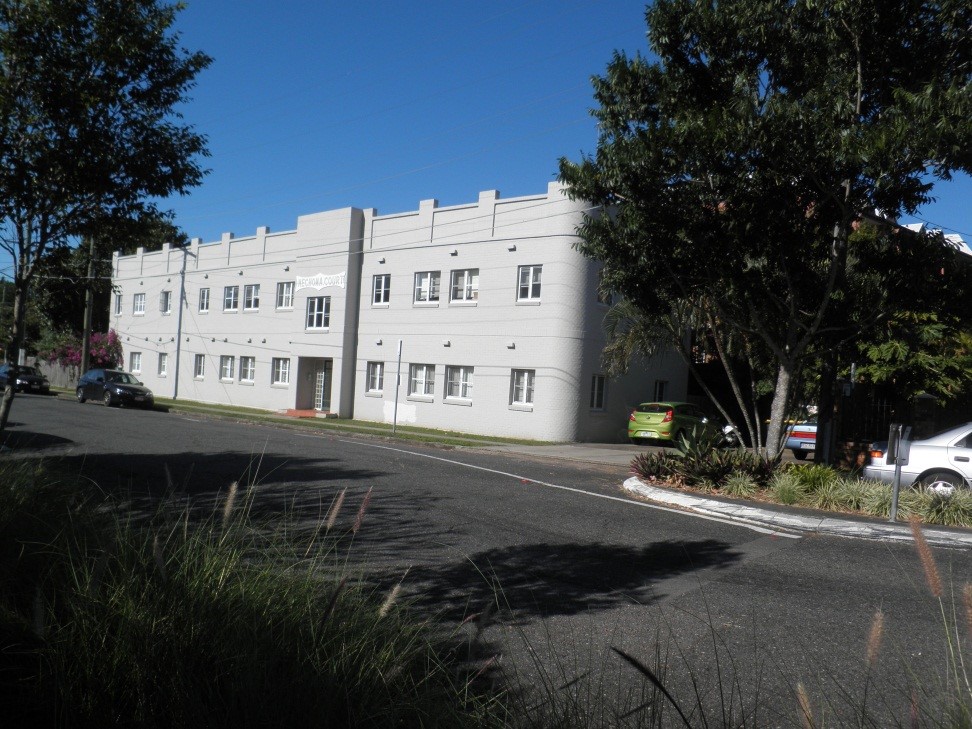Addresses
Type of place
Flat building
Period
Interwar 1919-1939
Style
Art Deco
Addresses
Type of place
Flat building
Period
Interwar 1919-1939
Style
Art Deco
Nechoma Court is a set of set of brick interwar flats which hold a prominent position on the corner of Annerley Road and Gloucester Street, South Brisbane. Built in 1937 for South Brisbane resident, Jacob Levy, they are important in demonstrating Brisbane’s development pattern in the interwar period, in particular in South Brisbane, and the way in which ideas about acceptable forms of housing were changing.
Lot plan
L4_RP76601
Key dates
Local Heritage Place Since —
Date of Citation —
Construction
Walls: Masonry - RenderCriterion for listing
(A) Historical; (E) AestheticInteractive mapping
Lot plan
L4_RP76601
Key dates
Local Heritage Place Since —
Date of Citation —
Construction
Walls: Masonry - RenderCriterion for listing
(A) Historical; (E) AestheticInteractive mapping
History
As the Great Depression progressed in the late 1920s and into the 1930s a marked deficit of housing in Brisbane emerged. This was the period in which the multi-unit dwelling began to emerge as an alternative to the traditional Brisbane house and yard. Prior to this in larger Australian cities such as Sydney and Melbourne this style of ‘modern’ living, in blocks of flats, had become a stylish alternative to living in the traditional house.
In the early 1930s to cater for the housing shortage as well as to generate income many home owners in the inner-city suburbs converted houses into tenements, where tenants would share bathrooms, toilets and kitchens. This led to community concerns of overcrowding and increased hygiene problems. A fashionable and more sophisticated alternative to this form of accommodation was the purpose built block of self-contained flats. Marketed mainly at single people and childless couples the earliest self-contained flats in Brisbane were generally conveniently situated close to trams, trains and shopping facilities in inner-city suburbs such as Spring Hill, New Farm and Fortitude Valley.
The Brisbane City Council, in 1930, defined the flat as “a fully self-contained dwelling, with private kitchen, bathroom and water closet”. The flat was designed to be an independently functioning dwelling. Although seen as a sophisticated lifestyle, flat living was fairly uncommon in Brisbane in this period, with only 8.4% of Brisbane residents living in flats. This low percentage may be due to the economic constraints of the time as well as the perceived novelty of this style of living. Most interwar flats in Brisbane were architecturally designed and constructed from good quality brick and timber.
Nechoma Court was built in 1937 for clothing manufacture and South Brisbane resident, Jacob Levy who, with his wife Zena, purchased the property in 1937. The set of flats were built on the corner of Annerley and Gloucester Street and replaced a small shop and residence.
The flats were first listed in the Post Office Directories in 1938 and Levy was residing next door. In 1938 the flats were advertised in the Courier Mail, “Absolutely self-contained brick flat … 6 rooms, moderate rent, corner Annerley Rd, Gloucester Street, South Brisbane” (Courier Mail, 11 April 1938, p9). Nechoma Court holds a prominent position along Annerley Road and demonstrates the rise in popularity in the multi-unit dwelling in the interwar period in South Brisbane.
Description
Nechoma Court is a two-storey, rendered brick set of interwar flats situated on the corner of Gloucester and Annerley Road, Woolloongabba. There is a high parapet with decorative, interwar features including the name of the flats situated above the front entrance. There are a series of both timber casement windows and sash windows. The rear retains the original timber staircases. The interior retains many of the original internal interwar features.
Statement of significance
Relevant assessment criteria
This is a place of local heritage significance and meets one or more of the local heritage criteria under the Heritage planning scheme policy of the Brisbane City Plan 2014. It is significant because:
References
-
Courier Mail, 11 April 1938, p9
-
Brisbane City Council Minutes, 1935-36, p.764 & 918 and 1938, p.605
-
Brisbane City Council Metropolitan Water Supply and Sewerage Board, Detail Plans
-
Brisbane City Council, 1946 aerial photographs.
-
Certificates of Title, Department of Environment and Resource Management
-
Queensland Post Office Directories
-
Queensland Electoral Rolls
Citation prepared by — Brisbane City Council (page revised September 2020)

